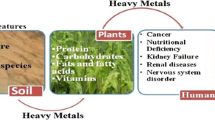Abstract
In the present study, selenium-enriched plant biomass was investigated to evaluate the ability of rye seedlings to take up, and assimilate, inorganic selenium. Two different analytical approaches were used. Electrophoretic separation (SDS-PAGE) of proteins extracted from 75Se-labelled biomass was used to investigate the biotransformation of selenite into organic forms of the element. Ion-pair chromatography coupled with ICP-MS detection was chosen for the analysis of selenium species, enzymatically extracted from the plant biomass. The results of three enzymatic hydrolysis procedures and three sequential enzymatic extractions procedures are compared. The most effective single extraction was proteolysis (using protease type XIV), giving an overall extraction efficiency of 48%. However, for combinations of enzymes, the most effective was cellulase (Trichoderma viride) followed by sequential extraction of the solid pellet using protease type XIV, giving an extraction efficiency of 70%. The complementary data from the electrophoretic fractionation of proteins, and the HPLC separation of Se-species in the proteolytic digests, reveal the existence of large number of selenium-containing compounds in the rye seedling plant biomass. The results showed the complete biotransformation of inorganic selenium into organic forms during germination of the rye seedlings. HPLC-ICP-MS analysis of extracts from the plant biomass did not show the presence of selenate or selenite. At the time of this study, the lack of suitable organic-MS facilities meant that it was not possible to characterise them fully. However, the data does show that a combination of different enzymes, rather than just the commonly-used protease, should be considered when developing an extraction strategy for selenium in different food types to those already reported in the literature.





Similar content being viewed by others
References
Combs GF (2001) Br J Nutr 85:517–547
Wasowicz W, Gromadzinska J, Rydzynski K, Tomczak J (2003) Toxicol Lett 137:95–101
Rayman M (2000) Lancet 356:233–241
Flohe L, Andreesen JR, Brigelius-Flohe R, Maiorino M, Ursini F (2000) IUBMB Life 49:411–420
Patrick L (2004) Altern Med Rev 9(3):239–258
Arthur JR, McKenzie RC, Beckett GJ (2003) J Nutr 133:1457S–1459S
Fairweather-Tait SJ (1999) Fresen J Anal Chem 363:536–540
Hakkarainen J (1993) Norwegian J Agric Sci Suppl 11:21–35
Chassaigne H, Chery CC, Bordin G, Vanhaecke F, Rodriguez AR (2004) J Anal Atom Spectrom 19:85–95
Sutton KL, Caruso JA (1999) J Chromatogr A 856:243–258
Szpunar J (2000) Analyst 125:963–988
Infante HG, O’Connor G, Rayman M, Wahlen R, Entwisle J, Norris P, Hearna R, Catterick T (2004) J Anal Atom Spectrom 19:1529–1538
Casiot C, Szpunar J, Lobinski R, Point-Gautier M (1999) J Anal Atom Spectrom 14:645–650
Michalke B, Witte H, Schramel R (2002) Anal Bioanal Chem 372:444–447
Quijano MA, Moreno P, Gutierrez AM, Perez-Conde MC, Camara C (2000) J Mass Spec 35:878–884
Encinar JR, Sliwka-Kaszynska M, Polatajko A, Vacchina V, Szpunar J (2003) Anal Chim Acta 500:171–183
Wrobel K, Kannamkumarath SS, Wrobel K, Caruso J (2003) Anal Bioanal Chem 375:133–139
Tan Y, Marshall WD (1997) Analyst 122:13–18
Dernovics M, Stefanka Zs, Fodor P (2002) Anal Bioanal Chem 372:473–480
Roberge MT, Borgerding AJ, Finley JW (2003) J Agric Food Chem 51:4191–4197
Bryszewska MA, Ambroziak W, Diowksz D, Lewis DJ (2005) Food Addit Contam 22(2):135–214
Chavan JK, Kadam SS (1989) Crit Rev Food Sci Nutr 28(5):401–437
Combs GF (1988) In: Chichester CO, Schweiger BS (eds) Advance in food research. Academic, San Diego, CA, pp 85–113
Brown TA, Shrift A (1982) Biol Rev 57:59–84
Terry N, Zayed AM, De Souza MP, Tarun AS (2000) Annu Rev Plant Physiol Plant Mol Biol 51:401–432
Bock A, Forchhammer K, Heider J, Leinfelder W, Sawers G, Veprek B, Zinoni F (1991) Mol Microb 5:515–520
Schrauzer G (2000) J Nutr 130:1653–1656
Anderson J (1993) In: De Kok LJ, Stulen I, Rennenberg H, Brunold C, Rauser WE (eds) Sulphur nutrition and assimilation in higher plants: regulatory agricultural and environmental aspects. SPB Ac. Publ., The Hague, The Netherlands, pp 49–60
Kobayashi Y, Ogra Y, Ishiwata K, Takayama H, Aimi N, Suzuki T (2002) Proc Natl Acad Sci USA 10:15932–15936
Han X-Z, Hamaker BR (2002) J Cereal Sci 35:109–116
Darlington HF, Tecsi L, Harris N, Griggs DL, Cantrell IC, Shewry PRJ (2000) J Cereal Sci 32:21–29
Acknowledgements
MAB would like to acknowledge KBN Grant No 6P06G 057 20 and CSL for supporting her work-visits to the UK.
Conflict of interest:
No information supplied
Author information
Authors and Affiliations
Corresponding author
Rights and permissions
About this article
Cite this article
Bryszewska, M.A., Ambroziak, W., Rudzinski, J. et al. Characterisation of selenium compounds in rye seedling biomass using 75Se-labelling/SDS-PAGE separation/γ-scintillation counting, and HPLC-ICP-MS analysis of a range of enzymatic digests. Anal Bioanal Chem 382, 1279–1287 (2005). https://doi.org/10.1007/s00216-005-3272-7
Received:
Revised:
Accepted:
Published:
Issue Date:
DOI: https://doi.org/10.1007/s00216-005-3272-7




